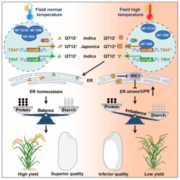Rewiring sugar signaling for global agriculture: A decade of progress in harnessing the T6P pathway
Rewiring sugar signaling for global agriculture: A decade of progress in harnessing the T6P pathway
 While sugar signaling plays a crucial role in grain filling and ultimately determines grain crop yield, direct genetic manipulation often results in pleiotropic effects and raises legislative concerns, limiting its practical application in agriculture. To address this, a “signaling-precursor” concept was introduced about a decade ago, involving the use of membrane-permeable analogues of trehalose-6-phosphate (T6P) to enhance plant performance. Unlike genetic modification, the external application of T6P analogues circumvents regulatory barriers and allows for flexible timing. In laboratory settings, such treatments have been shown to increase grain number, sugar content, and resilience to dehydration in both Arabidopsis and wheat. In a recent study, Griffiths and colleagues of the same research group validated the potential of this approach under field conditions. Three wheat cultivars were grown in field trials over four years, and their performance under dehydration stress was assessed. Remarkably, chemical treatment enhanced both source processes (CO₂ fixation and energy production) and sink processes (starch biosynthesis and endosperm enlargement), resulting in a 9–22% increase in wheat yield. Moreover, this technology is also effective in other cereals, such as sorghum and barley, underscoring the broad application potential of targeting the T6P signaling pathway in agriculture. (Summary by Ching Chan @ntnuchanlab) Nature Biotechnology 10.1038/s41587-025-02611-1
While sugar signaling plays a crucial role in grain filling and ultimately determines grain crop yield, direct genetic manipulation often results in pleiotropic effects and raises legislative concerns, limiting its practical application in agriculture. To address this, a “signaling-precursor” concept was introduced about a decade ago, involving the use of membrane-permeable analogues of trehalose-6-phosphate (T6P) to enhance plant performance. Unlike genetic modification, the external application of T6P analogues circumvents regulatory barriers and allows for flexible timing. In laboratory settings, such treatments have been shown to increase grain number, sugar content, and resilience to dehydration in both Arabidopsis and wheat. In a recent study, Griffiths and colleagues of the same research group validated the potential of this approach under field conditions. Three wheat cultivars were grown in field trials over four years, and their performance under dehydration stress was assessed. Remarkably, chemical treatment enhanced both source processes (CO₂ fixation and energy production) and sink processes (starch biosynthesis and endosperm enlargement), resulting in a 9–22% increase in wheat yield. Moreover, this technology is also effective in other cereals, such as sorghum and barley, underscoring the broad application potential of targeting the T6P signaling pathway in agriculture. (Summary by Ching Chan @ntnuchanlab) Nature Biotechnology 10.1038/s41587-025-02611-1





